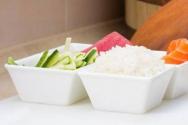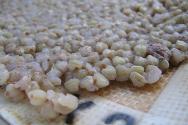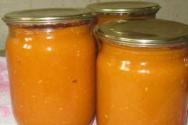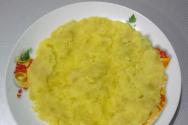BBQ Magazine: Archive. Extraordinarily tasty Georgian sauce: tkemali - cooking recipes Add herbs and finely chopped garlic
The Legend of Tkemali
Red and green meat accompaniment
Georgian cuisine in its structure is actually extremely heterogeneous and varies greatly from locality to locality and from nationality to nationality - Western is not similar to Eastern, Svan - to Mingrelian, Adjarian - to Imeretian, Tushino - to Kakheti and so on.
However, there is also something unifying, first of all this applies to sauces. Thus, the Abkhazian adjika has long and firmly spread not only to the whole of Georgia, but also to the entire North Caucasus; pomegranate narsharabi came from Azerbaijan and firmly established itself here; Satsivi and Bazhe are loved everywhere; Satsebeli, depending on the area, can be nut or tomato. But the most widespread, far beyond the Caucasus, can perhaps be considered tkemali.
What is what?
 There is eternal confusion with tkemali, since this sauce comes in red and green. The more famous red tkemali is made from black wild thorns, and green tkemali is made from sour unripe plums, such as cherry plums, which are actually called tkemali. Since the remaining ingredients are exactly the same, both sauces are called by one collective term - tkemali.
There is eternal confusion with tkemali, since this sauce comes in red and green. The more famous red tkemali is made from black wild thorns, and green tkemali is made from sour unripe plums, such as cherry plums, which are actually called tkemali. Since the remaining ingredients are exactly the same, both sauces are called by one collective term - tkemali.
Red tkemali is often made from dry herbs and spices, while green tkemali, which begins to be prepared a couple of months earlier, is made with a predominance of fresh herbs. The composition itself varies from region to region and from house to house: in fact, only ombalo (field grass or flea mint), garlic and hot pepper, both fresh and dry, are absolutely required. Almost always crushed coriander seeds are placed in tkemali. Other ingredients are at your personal discretion: fresh cilantro, basil, tarragon, mint - can be used separately, or all together.
The origin of tkemali is lost in the mists of time, and it is impossible to date the emergence of this idea with any certainty. Both blackthorn and local plum do not require special care; they grow on their own, while bearing fruit annually and, as a rule, very abundantly. However, if you let the cherry plum-tkemali turn a little yellow and ripen, it gains sweetness and becomes easy prey for all kinds of worms and birds. Perhaps this is why a recipe using unripe, green fruits was born. Sloes are used mainly for preparing tkemali and tklapi - more on the latter a little later.
What's with what?
 Preparing tkemali is not easy, but very simple. It's better to start with green tkemali, since green cherry plum appears already in April - May and remains in stock almost until autumn. Blackthorn does not appear in markets very often. Although wild blackthorn grows everywhere in the European part of Russia, you just can’t find it right away.
Preparing tkemali is not easy, but very simple. It's better to start with green tkemali, since green cherry plum appears already in April - May and remains in stock almost until autumn. Blackthorn does not appear in markets very often. Although wild blackthorn grows everywhere in the European part of Russia, you just can’t find it right away.
So, let's begin. The plum is washed and transferred to enamel pan, fill it with cold well or spring water just to cover, and put it on the fire. Some people recommend cutting plums in half, but I, for example, don’t see much technological sense in this, and besides, doing this with green variety not an easy task.
 Despite the fact that green plums are very hard, they boil very quickly, in 5–7 minutes. And in a big way, which is what we need. After this, put a colander in another pan and drain the plums, making sure to save the broth! We push the drained plum through a colander, in which the skins and seeds are safely retained, and the internal contents go into the first pan. Next, slightly dilute the punched plum with part of the saved broth (just don’t pour a lot), put it on low heat and chop the herbs, garlic and pepper. There is no need to cut it very finely, as for green adjika, since the grass can boil. Tkemali – the sauce is quite liquid, so there is no need to boil it down too much. Mix in the chopped herbs, crushed garlic and pepper with salt and boil everything together for a minute. Actually, that's all.
Despite the fact that green plums are very hard, they boil very quickly, in 5–7 minutes. And in a big way, which is what we need. After this, put a colander in another pan and drain the plums, making sure to save the broth! We push the drained plum through a colander, in which the skins and seeds are safely retained, and the internal contents go into the first pan. Next, slightly dilute the punched plum with part of the saved broth (just don’t pour a lot), put it on low heat and chop the herbs, garlic and pepper. There is no need to cut it very finely, as for green adjika, since the grass can boil. Tkemali – the sauce is quite liquid, so there is no need to boil it down too much. Mix in the chopped herbs, crushed garlic and pepper with salt and boil everything together for a minute. Actually, that's all.
 It makes sense to adjust cooled tkemali for salt and spiciness. Sugar is added only if the plum is very sour. Additionally, after 2-3 days, when the taste is finally balanced, you can add more salt and finely ground red hot pepper. Ready tkemali is usually bottled, a spoonful of olive or other vegetable oil is poured into the neck, sealed and stored in a cool place. In urban conditions, tkemali is securely stored in the refrigerator in ordinary jars with screw or vacuum lids.
It makes sense to adjust cooled tkemali for salt and spiciness. Sugar is added only if the plum is very sour. Additionally, after 2-3 days, when the taste is finally balanced, you can add more salt and finely ground red hot pepper. Ready tkemali is usually bottled, a spoonful of olive or other vegetable oil is poured into the neck, sealed and stored in a cool place. In urban conditions, tkemali is securely stored in the refrigerator in ordinary jars with screw or vacuum lids.
What else?
If you remember, we still had plum broth left. From it you can prepare a by-product of the production of tkemali and tklapi - kvantsarahi sauce. The broth needs to be reduced two to three times, adding salt and hot pepper. Garlic is most often not included, but there are options with garlic. The boiled broth is filtered and bottled, the result is very pleasant to the taste. sour sauce or a seasoning very reminiscent of the now forgotten, but once extremely popular French verjus, which was prepared from green grapes, sorrel and various sour berries and fruits.
 Well, one last thing. From a plum punched through a sieve or colander, you can not make tkemali, but make tklapi. To do this, the plum mass must be carefully boiled down again, stirring constantly, lightly sugared and salted, spread in a thin layer on a wet board or sheet of paper and placed in the sun (for example, on the roof of a barn). The mass, set in the sun, turns into thin plates, which are turned over from time to time and then dried on ropes. Then it is rolled up into a tube or pound and stored indefinitely. Tklapi is used in kharcho, for preparing winter sauces, or simply fed to children. It is believed that tklapi is very helpful for sore throats - children are given dry pieces to suck until the sore throat goes away. Either tklapi actually has benefits, or it’s just the swallowing exercises that work, but it helps! It is clear that in urban conditions you can not climb onto the roof, but spread the mashed plum on baking paper and dry it at 70 ° C in an oven with convection or fan. Everything is pretty fast. And very similar to the old Russian left-handed berries.
Well, one last thing. From a plum punched through a sieve or colander, you can not make tkemali, but make tklapi. To do this, the plum mass must be carefully boiled down again, stirring constantly, lightly sugared and salted, spread in a thin layer on a wet board or sheet of paper and placed in the sun (for example, on the roof of a barn). The mass, set in the sun, turns into thin plates, which are turned over from time to time and then dried on ropes. Then it is rolled up into a tube or pound and stored indefinitely. Tklapi is used in kharcho, for preparing winter sauces, or simply fed to children. It is believed that tklapi is very helpful for sore throats - children are given dry pieces to suck until the sore throat goes away. Either tklapi actually has benefits, or it’s just the swallowing exercises that work, but it helps! It is clear that in urban conditions you can not climb onto the roof, but spread the mashed plum on baking paper and dry it at 70 ° C in an oven with convection or fan. Everything is pretty fast. And very similar to the old Russian left-handed berries.
As for sloe, the process is practically no different, except that, as already mentioned, the composition is dominated by dry herbs and seeds - ombalo, coriander, oregano, savory (kondari). In the absence of sloe, if desired, you can replace it with small and as sour dark plums as possible, but they are also rare, and you will have to acidify the sauce with something. Alternatively, you can make it red wine vinegar, a worse option is lemon, but there must certainly be a distinct sourness in the sauce. I won’t say what exactly tkemali will turn out to be, but it will be delicious.
And the very last thing. Tkemali best accompanies cold meat dishes without a strong taste of its own - roasted pig, baked or boiled meat or chicken, boiled fish etc.
Stunning Georgian cuisine has always been distinguished by tasty, juicy and aromatic dishes. We have already cited it earlier. Now let's talk about Kharcho soup. His recipe is completely uncomplicated, as is commonly believed about Georgian dishes. All products are familiar to us and are always available in grocery stores. You don’t have to spend a large amount of money or a lot of time on preparation.
Beef Kharcho soup is prepared quite quickly, especially if you follow the photo or video recipe. Also on the Internet you can find many variations: with other meat, tomatoes instead of cherry plum, without nuts and others.
Description
The amazing beef soup Kharcho, originally from Georgia, stands out among other first courses for its ingredients. Beef meat is unlikely to surprise anyone: it is juicy and reminds us of the May holidays. But you don’t see nuts in soup every day.
And finally distinctive feature This dish can rightfully be called cherry plum puree - tkemali. Of course, every Georgian woman who is experienced in cooking makes her Kharcho soup unique thanks to various spices and proportions of ingredients.
Our hostesses adapted classic recipe for different living conditions, for example, in areas where cherry plum does not grow, they replaced tkemali tomato sauce. Others use pomegranate juice. And some don't even use nuts. Others completely turn beef Kharcho soup into a pork, lamb or chicken dish. The traditional ingredients remain onions and rice.
To add a piquant taste, Georgians add sprigs of parsley, fresh dill, various spices and always greens, which have been known for at least 500 years. Majority Georgian dishes Can’t do without the Khmeli-Suneli spice mixture.
The cooking method is quite simple. To begin, the meat is separated from the bones, the films are removed and cut into pieces. It is boiled in water for about two hours, then taken out for frying with onions in oil. And the broth is filtered. Then tomatoes or tkemali are added. Then all the ingredients, along with rice and nuts, are placed in the broth and boiled for 5 minutes. At the end, spices and herbs are added. The main thing is to let the soup brew.
Required Products
 Typically, a recipe for beef Kharcho soup involves purchasing the following products:
Typically, a recipe for beef Kharcho soup involves purchasing the following products:
- 300 g beef;
- 100 g rice;
- 2-3 pcs. onions;
- 150 g tkemali sauce (can be replaced with satsebeli);
- 1 cup walnuts;
- 2 cloves of garlic;
- 3 bay leaves;
- 3 peas of allspice;
- 1-2 teaspoons hops-suneli;
- 3 tbsp. l. tomato paste;
- 1/2 tsp. ground red pepper;
- Half a red capsicum;
- 4 sprigs of cilantro and parsley;
- 2 branches of dill;
- 1-1.5 tsp. salt and vegetable oil.
Some also use plums, tomatoes and various meats for cooking.
Cooking technology
 There is nothing complicated in the classic recipe for making beef Kharcho, because all the ingredients are easy to buy and even tkemali sauce can be replaced with satsebeli sauce, which is available to the average buyer. When all the ingredients are collected on the table, we begin to cook the broth. Beef brisket is poured with cold water and cooked for about two hours.
There is nothing complicated in the classic recipe for making beef Kharcho, because all the ingredients are easy to buy and even tkemali sauce can be replaced with satsebeli sauce, which is available to the average buyer. When all the ingredients are collected on the table, we begin to cook the broth. Beef brisket is poured with cold water and cooked for about two hours.
From time to time you need to skim off the foam, and in the meantime, chop the onion and chop the walnuts. Chop the greens and wash the rice in cold water. We start preparing the frying: fry the onion, pour in the tomato paste and after 5 minutes add suneli hops and chopped garlic, chopped or whole red pepper.
Let it cool, by which time we take the cooked beef out of the broth and cut it into pieces. It can also be fried. Then add rice, beef and allspice to the broth one by one. After 10-15 minutes, pour in the roast and walnuts. We also add herbs, sauce and bay leaf. Add salt and turn off the heat after five minutes. Before serving, you need to let the dish brew.
Step-by-step instruction

- First, we place our ingredients on the table;
- Place the meat in a large deep pan and fill with 3 liters of cold water. For taste, you can also add peeled carrots and onions, bay leaves and allspice, as for regular broth. Salt and cook for at least two hours until tender;
- Then take out the meat and vegetables (if you put them in) and strain the broth through a sieve into another pan;
- Now finely chop the garlic cloves and turn them into a paste;
- We also coarsely grate the carrots and chop the onion;
- Fry these components in a frying pan along with tomato paste;
- To prevent the frying from becoming thick, add one ladle of broth;
- Now you can pour the roast into the boiling broth;
- Separate the meat from the bones and cut into pieces along the grain;
- Then add washed rice and boiled meat to the broth. Add chopped herbs and spices. Cook the soup until the rice is ready. Before serving, you need to let Kharcho brew.
 Dishes from Georgian cuisine can be seen on every table today. What housewife doesn't know how to cook? This tasty treat can be made from ready-made puff pastry.
Dishes from Georgian cuisine can be seen on every table today. What housewife doesn't know how to cook? This tasty treat can be made from ready-made puff pastry.
Georgian cuisine is unique, even from seemingly the most plain meat chicken, can be cooked gourmet dish. You can see the recipe on how to cook Georgian chicken Satsivi. A main secret Satsivi is that each housewife turns out the dish in her own way.
Photo recipe for beef kharcho
For clarity, we suggest looking at the detailed process of preparing the soup. We hope that it will help you surprise your loved ones and friends.
Prepare the ingredients

Cut the onion into half rings

Pour over the lamb cold water and cook the broth. Cook the broth over medium heat for 40 minutes

Place the onion in a frying pan heated with vegetable oil.

Add tomato paste fry
![]()
Remove the meat from the finished broth

Add onion fried with tomato paste to the broth. The broth should simmer over medium heat

Add rice

Add tkemali and adjika

When the rice is almost ready, return the meat to the soup.

Add spices

Salt and pepper

Add sugar to taste

Add diced tomatoes
![]()
Add greens and finely chopped garlic

Bring the soup to a boil and remove from heat

Pour the soup into bowls or pots. Grate the walnuts on a fine grater

Bon appetit
![]()
Video to help housewives
For those who want to get acquainted with the traditional Kharcho recipe, we provide a video in which all stages of preparation are described in great detail.
Ilya Lazerson in his program “Lazerson. Favorite” will demonstrate a video recipe for making beef Kharcho.
The master is charming and magnificent as always!
I never knew that kharcho needed itskho-suneli herb. I’ll definitely try to get the necessary spices and cook kharcho for my son, for whom this is his favorite soup. By the way, he knows how to cook it himself, but some difficulties have been added... Ilya, thank you so much for the “Principles”! I really thought that after the “Celibacy Lunch” I would no longer see programs of this type, but this is how it turned out...
Dear Ilya! Thank you SO MUCH for the recipe! I have never seen such nuances before on the Internet. I always enjoy watching your programs. Quite by accident I came across utskho-suneli in the store right after the broadcast about kharcho! I'll definitely cook it!
Wow, how delicious it turned out. Health and longevity to the giver of the principle
I like the way you present your recipes in a simple, accessible way. Very tasty soup
it turns out. I watched on television and read how to cook it correctly. Thank you, Ilya, it’s nice to listen to the explanations. It’s delicious.
Thank you, maestro! Last week I made your processed cheese soup, I really liked it. Today I want kharcho :)
All cooks do not even mention foam when preparing broths. Ilya mentioned, but did not show what and how he does it, and most importantly, why? Many people on the net gently believe in the type of pren - it is a folded protein; moreover, they claim that it is even useful. And everyone as one mentions that they remove the foam only so that the broth is not cloudy. My opinion is that foam is harmful. In our body, over the course of a short or long life, poisons and substitutes, radiation in the form of free radicals, etc. accumulate. When heated and boiled, something naturally precipitates, and there are decomposition products. If the ancestors of smart people collected foam with a mini or micro slotted spoon, a spoon with holes no larger than 3 mm and a long handle. Well, nowhere do they show how to remove the foam. It seems that this is an optional attribute when cooking vegetables, meat and fish.
Obizatelno prigotovlu! Sama iz Tbilis, no vi tak pravilno i podrobno opisali process, chto posle prosmotra xochetsya bejat pokupat rebrishki govyajie i gotovit! Thank you vam, za vashi video, ya ix obojau i vsegda naxoju something to new i ineteresnoe dlya sebya!
Dear Ilya Isaakovich! You are the best! But! Try my recipe. This is not your classic kharcho, but it is incredibly tasty. The difference in my recipe is that in addition to everything you indicated, finely chopped smoked prunes, very little finely chopped carrots are added to the soup, and most importantly - we take walnuts, pour tkemali over them and bring them in a blender to a thin paste without lumps. Then add the sauce to the soup. These ingredients are fully consistent with the traditions of Georgian cuisine and harmoniously combine with classic ones. The soup turns out thick, not like regular kharcho. Nuts dampen the spice a little and therefore it is advisable to have more hot pepper, but this is my personal opinion. In fact, the classic is not spicy at all, but aromatic. But the presence of nuts in the soup is still a Georgian tradition, and it’s unclear why you don’t follow it. Regarding foam. We always boil meat at home. When the foam comes out, don’t just skim it off, but drain the water, wash the meat and then start cooking in the second water. The broth is as clear as a tear, the main thing is that it does not boil with bubbles. Besides, why didn’t you mention Imeretian saffron? Without it, kharcho is not kharcho. With deepest respect and hope for your answer Rumata.
Thanks, I'll definitely learn it
Dear Ilya! Thank you SO MUCH for the recipe! I have never seen such nuances before on the Internet. I always enjoy watching your programs. Quite by accident I came across utskho-suneli in the store right after the broadcast about kharcho! I'll definitely cook it! All cooks do not even mention foam when preparing broths. Ilya mentioned, but did not show what and how he does it, and most importantly, why? Many on the net gently believe in the type of pren - it is a folded protein; moreover, they claim that it is even useful. And everyone as one mentions that they remove the foam only so that the broth is not cloudy. My opinion is that foam is harmful. In our body, over the course of a short or long life, poisons and substitutes, radiation in the form of free radicals, etc. accumulate. When heated and boiled, something naturally precipitates, and there are also decomposition products. If the ancestors of smart people collected foam with a mini or micro slotted spoon, a spoon with holes no larger than 3 mm and a long handle. Well, nowhere do they show how to remove the foam. It seems that this is an optional attribute when cooking vegetables, meat and fish. Dear Ilya Isaakovich! You are the best! But! Try my recipe. This is not your classic kharcho, but it is incredibly tasty. The difference in my recipe is that in addition to everything you indicated, finely chopped smoked prunes, a very small amount of finely chopped carrots are added to the soup, and most importantly - we take walnuts, fill them with tkemali and use a blender to bring them to a thin paste without lumps. Then add the sauce to the soup. These ingredients are fully consistent with the traditions of Georgian cuisine and harmoniously combine with classic ones. The soup turns out thick, not like regular kharcho. Nuts dampen the spice a little and therefore it is advisable to have more hot pepper, but this is my personal opinion. In fact, the classic is not spicy at all, but aromatic. But the presence of nuts in the soup is still a Georgian tradition, and it’s unclear why you don’t follow it. Regarding foam. We always boil meat at home. When the foam comes out, don’t just skim it off, but drain the water, wash the meat and then start cooking in the second water. The broth is as clear as a tear, the main thing is that it does not boil with bubbles. Besides, why didn’t you mention Imeretian saffron? Without it, kharcho is not kharcho. With deepest respect and hope for your answer Maxim.
Everything is fine, but we don’t have fenugreek anywhere in the city, not even in the market. At one time it was sold there under the name "Shambhala", but now even that is gone. Don't cook kharcho?
I read in one good book how to cook Kharcho - and now I cook it the only way!! Everything in principle - Same, but... in Kharcho, chopped walnuts must be added - about half a glass for a 3-liter pan. Nuts are added about 15-20 minutes before the end of cooking! Try it - and you will be Surprised!
Ingredients
Instructions
Ingredients: beef pulp - 500 g;onion - 2 pcs.; rice- 1/2 cup; tomatoes - 2 pcs.; tomato paste - 1 tbsp. l.; garlic- 4 cloves; red tkemali sauce - 1 tbsp. l.; vegetable oil - 2 tsp.; adjika- 1 tsp.; hot pepper- taste; parsley - 1/4 bunch; cilantro- 1/2 bunch; celery greens - 1/8 bunch; utskho-suneli or khmeli-suneli -1 tsp
Cut beef into large cubes and cook the broth. Chop the tomatoes and By simmer, then wipe. Cut the onion into half rings and fry in oil until golden brown. Add mashed tomatoes, tomato paste to the frying pan and simmer with onions for 15 minutes, without letting it burn. Add the tomato-onion mixture, washed rice to the broth with meat and cook for 10 minutes. Then add utskho-suneli, adjika, tkemali, hot pepper, on chopped greens and crushed garlic. Turn off the heat, cover and let sit for 15 minutes..
To prepare tkemali, I will, of course, need plums, mint (in the classic Georgian recipe you need pennyroyal, it is called “ombalo”, it has a richer smell, but any mint will do, it won’t make the taste worse, you can use it either dried or fresh), garlic, ground red pepper, fresh cilantro and coriander, that is, dried cilantro seeds, as well as salt.
In principle, all seasonings for plums are to taste, the main thing is the presence of these ingredients.
First of all, wash the plums, place them in a saucepan or tank, depending on the amount of plums, add water, and bring to a boil.
You need to achieve such an effect that the plum becomes soft and the skin cracks a little.
Then we will salt some of the broth, and leave a small amount, about 1-2 glasses, it may be useful to us later.
Let's pass the plum through a colander and mash it. For tkemali, we only need the pulp from the plum; all that remains in the colander - the pit and the skin - does not go into tkemali.
I initially cooked 8 kg of plums, but in the end I got about 3.5 liters of pulp for further preparation of tkemali.
Then we put this pureed pulp back on low heat, it is necessary that it boils slightly, periodically stir it in the pan.
Now let's deal with spices and seasonings.
2-3 tbsp. Add tablespoons of dried mint (ombalo) to the pan and stir.
Dried cilantro seeds 2 tbsp. l., that is, coriander, pass through a blender and also add to the pan, but we must throw another 2 tablespoons into the tkemali unground.
Then we’ll take fresh cilantro (exactly the kind you see in the video that goes into tkemali), separate the branches and inflorescences from the sticks. The sticks do not go into the sauce, only the soft parts of the cilantro.
The cilantro also needs to be chopped in a blender and also added to the pan with the future sauce.
Now garlic, 6-7 large cloves, it also needs to be brought to a pasty state in a blender and added to the sauce simmering over low heat.
At the end, add 0.5 tsp ground red hot pepper and 3-3.5 tbsp salt. spoons., mix everything thoroughly again and leave on the gas for another 5 minutes. If it seems to us that the sauce is too thick, this is where that decoction of plums comes in handy to dilute the sauce with it to the consistency you need.
Then turn off the gas - the tkemali is ready.
For further storage, it needs to be poured into sterilized small jars, because when opening and using the sauce, it cannot be stored for a long time, plums are a very finicky product in this regard, and of course there are no preservatives...
It is advisable to store jars in a cool place, in a cellar or in the refrigerator.
The sauce is consumed cold, mainly used with fish, meat, poultry, and a side dish of potatoes and pasta.
Bon appetit!
Ingredients
Instructions
Ingredients: beef pulp - 500 g;onion- 2 pcs.; rice- 1/2 cup; tomatoes - 2 pcs.; tomato paste - 1 tbsp. l.; garlic- 4 cloves; red tkemali sauce - 1 tbsp. l.; vegetable oil - 2 tsp.; adjika- 1 tsp.; hot pepper- taste; parsley - 1/4 bunch; cilantro- 1/2 bunch; celery greens - 1/8 bunch; utskho-suneli or khmeli-suneli -1 tsp.
Beef cut large cubes and cook the broth. Chop the tomatoes and By simmer, then wipe. Cut the onion into half rings and fry in oil until golden brown. Add mashed tomatoes, tomato paste to the frying pan and simmer with onions for 15 minutes, without letting it burn. Add the tomato-onion mixture, washed rice to the broth with meat and cook for 10 minutes. Then add utskho-suneli, adjika, tkemali, hot pepper, on chopped greens and crushed garlic. Turn off the heat, cover and let sit for 15 minutes..
Tkemali is traditional Georgian sauce, which has a sweet and sour taste and spicy spiciness. It fits perfectly meat dishes. This sauce is usually made from sour plums. However, there are other recipes for tkemali, which are based on gooseberries, sloe, apples, currants and other products. However classic version They are made from plums.
Cooking secrets
Before we start looking at tkemali recipes, it’s worth citing a few secrets of its preparation. By following them, you can create an excellent sauce for meat dishes. By the way, any housewife can cook tkemali at home. After all, this does not require special skills or specific equipment. It is enough to follow the recipe and adhere to some rules. So, the secrets of preparing tkemali:
- No oil or vinegar is added to this sauce. The workpiece is stored for a long time thanks to heat treatment, as well as spices that are part of it and are particularly spicy. Even with room temperature the product will not deteriorate. The most important thing is properly prepared jars. They must be thoroughly washed, sterilized and hermetically sealed.
- It is best to prepare tkemali from plums, preferably sour varieties. Some professionals recommend using slightly unripe fruits for this.
- To prevent plums from burning during heat treatment, they must be stirred regularly. It is recommended to use a wooden spatula for this. As for metal utensils, they should not be used. Although the exception is stainless steel products.
- To cook the sauce, you should use only enamel or stainless steel containers. Aluminum pans can spoil the product. In addition, this metal, when in contact with acids, releases substances harmful to human health.
- When studying the tkemali recipe, pay special attention to seasonings. They allow you to flavor the sauce unique taste and aroma. To make tkemali original, mint is added to it, which is often replaced with peppermint. Only a true connoisseur of Georgian cuisine can notice the difference.
- To prepare this sauce, plums should be crushed. To do this, according to the classic tkemali recipe, they are boiled and ground through a regular sieve. Thanks to this, the sauce acquires a thinner and more delicate structure. If this is not important, then you can grind the components using a blender or pass everything through a meat grinder. This will greatly simplify and, of course, speed up the process.
- When calculating the number of components, it is necessary to take into account that to obtain a thick product, it is boiled almost 4 times.

Sauce recipe
Let's look at the classic recipe for making tkemali. To do this you will need:
- 3 kg pitted sour plums;
- 2 heads of garlic;
- 200 g cilantro (fresh);
- ½ cup sugar;
- 4 tbsp. l. regular salt;
- 10 g of pennyroyal or peppermint;
- several hot peppers.
Cooking steps
So, how to cook tkemali? First you need to prepare the main component - plums. Peel them, add sugar (about 3 tablespoons) and place in a cool place for a while. The plums should stand and release their juice. Place them on the stove and turn up the heat. If there is not enough juice, add a little water (preferably boiled). Bring the contents to a boil and simmer for some time (5-10 minutes). Finally, grind the plums through a regular sieve.
Place the plum puree on the stove and turn on the heat. Cook the mass until its volume decreases by 3-4 times. When this happens, add chopped garlic, ground hot pepper in a blender, remaining sugar, chopped herbs, salt and suneli hops to the sauce. Cook the mixture for another 10-15 minutes.
Place the finished tkemali sauce in prepared jars (washed and sterilized). Close the containers with previously boiled lids. Once the jars have cooled, move the jars to a cooler place, such as a pantry.

Simplified version
Many people prepare tkemali from cherry plums, but it is best to use plums to make the sauce. Let's look at a simplified recipe:
- 1.5 kg of sour plums;
- 20 g regular salt;
- 50 g sugar;
- 20 g of spices (khmeli-suneli);
- about 2 heads of garlic;
- no more than two pods of hot pepper.
Let's start cooking
First, peel the plums and then grind them using a blender. Add sugar and, of course, salt to the resulting mass. Place the container with plums on the fire. Cook the mass until its original volume decreases by 2-3 times.
Peel the garlic and chop it together with the hot pepper, previously cleared of seeds, using a blender. Add the mixture, as well as dry spices, to the container with the plums. Cook the tkemali sauce for another 6-7 minutes. Remove the finished product from the heat, pour into sterilized jars and seal tightly.

Is there a difference?
Is the sauce prepared according to a simplified recipe different from the classic one? You can even store it at room temperature. The main thing is that the containers are hermetically sealed. As for taste, there are differences. Tkemali, prepared according to a simplified recipe, turns out to be less salty and more spicy.
Yellow plum sauce
To prepare tkemali according to this recipe you will need:
- 1 kg peeled yellow plums;
- from 20 to 40 g of sugar;
- 30 g salt;
- head of garlic;
- 1 hot pepper;
- 50 g cilantro (fresh);
- 50 g fresh dill;
- 10 g ground coriander.
The amount of sugar depends on how sweet the plum is. If necessary, the amount of this component can be increased.

So, let's begin…
Tkemali for the winter according to this recipe is prepared quickly and simply. First, remove the pits from the plums and then chop them. To do this, you can use a meat grinder or blender. The latter option is preferable, since it is recommended to avoid contact of products with metal.
Peel the garlic and then crush it. Hot peppers also prepare. It needs to be cleared of seeds and chopped. Finely chop the greens. Add sugar and salt to the yellow plum puree. Cook the mass until it reduces in volume by 2 times. Cool and add coriander, garlic, pepper and herbs. Bring the sauce to a boil and cook for a few minutes.
Pour the finished tkemali into sterilized jars and seal tightly. You can store the workpiece in any conditions: in the pantry, cellar, refrigerator. The sauce is not fussy and tolerates room temperature well.
Preparation of tomatoes and plums
To prepare red tkemali, you need to prepare the following products:
- approximately 1 kg of plums;
- 1.5 kg of red tomatoes;
- 750 g sweet pepper;
- 500 g onions;
- 500 g apples, preferably sour varieties;
- 1 hot pepper;
- salt, fresh herbs, sugar.

Cooking method
First, pour boiling water over the tomatoes. This will allow you to remove the skin from them. Grind the tomato pulp in a blender. Place the plums in a saucepan, cover with water, cook for no more than 5 minutes, then remove them from the heat and rub through a regular sieve.
Peel and chop the apples using a grater. Do the same with the onion. A blender can be used to grind it. Prepare the other ingredients in the same way: hot and sweet peppers.
Mix all the ingredients in a container and place it on the fire. Cook the sauce until you reach the desired consistency. Place the finished plum and tomato tkemali in sterilized containers and seal tightly. Of course, the taste of such a preparation is significantly different from that prepared according to the classic recipe.
Is it possible not to cook?
There is a recipe for plum tkemali, where the components do not pass through heat treatment. Let's take a closer look at it. To prepare the sauce you will need:
- about 1.2 kg of already pitted plums;
- from 2 to 4 pods of hot pepper;
- head of garlic;
- no more than 50 g of basil;
- 50 g cilantro;
- approximately 25 g peppermint;
- 20 g regular salt without additives;
- 20 g white sugar.

Cooking process
To make this sauce, grind plums, peeled garlic, and seeded peppers using a blender. Chop the greens in the same way. Combine all ingredients and mix. Add salt and sugar to the resulting mass. To mix everything well, use a blender or mixer.
Sterilize jars and lids. Place the prepared sauce in containers and seal tightly. This product must be stored in a cool place. At room temperature, the sauce will spoil and will not last until the end of winter.
It is worth noting that this method of preparation allows you to preserve the maximum amount of all useful substances in the finished tkemali.
Recipe with pomegranate juice
To prepare an extraordinary sauce, prepare:
- 2 kg plums;
- from 60 to 80 g sugar;
- salt to taste;
- coriander;
- khmeli-suneli;
- 1 head of garlic;
- 100 ml natural pomegranate juice.
Grind the plums, first removing the pits. Add salt, dry spices and sugar to the resulting puree. Place the mixture on the fire, bring to a boil and cook until the sauce thickens.
Peel the garlic, pass it through a press and add it to tkemali. Pour in the pomegranate juice, stir everything and cook for 5 minutes. Pour the finished sauce into sterilized glass containers and close tightly. The workpiece can be stored at room temperature. This sauce is perfect for meat dishes. And it’s easy and quick to prepare. Now you know how to cook tkemali.
Source: fb.ru







